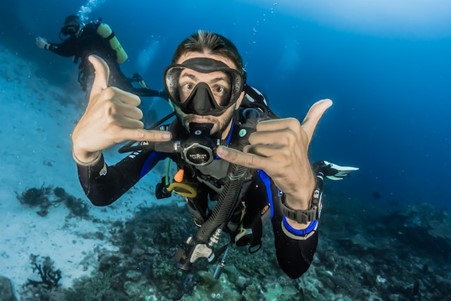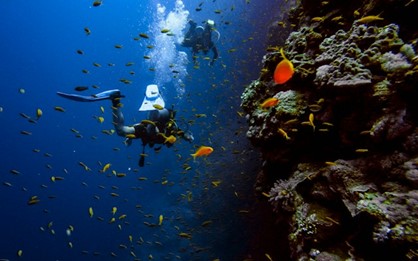David Mulhauser is a frequent traveler, scuba diver, and seasoned guide, orchestrating the ultimate symphony of adventure for scuba enthusiasts. In the following article, David Mulhauser navigates the uncharted waters of dive travel, where every plunge is not just a descent into the abyss but a meticulously planned odyssey transforming an ordinary adventure into an extraordinary exploration of the mesmerizing wonders that lie beneath the surface.
Scuba diving remains one of the most popular water sports in the world!
In 2022, about 2.7 million Americans scuba-dived at least once that year, according to the Business of Diving Institute. It was a 7.3 percent increase from the previous year and the same number of individuals who scuba-dived before the pandemic – a sign that people are back to scuba diving!
Planning to go scuba diving? Follow our comprehensive guide to planning a scuba diving vacation, including destination recommendations, packing tips, and insights into the best times to explore different underwater environments.
David Mulhauser Highlights the Scuba Diving Vacation Planning Guide
Step 1 – Get a Scuba Diving Certification
David Mulhauser says that while scuba diving is a fun recreational activity, it also poses some risks since one will be underwater for some time. It’s recommended that individuals planning a scuba adventure take a diving certification class beforehand.
The National Association of Underwater Instructors (NAUI), headquartered in Tampa, Florida, offers recreational dive certifications and has instructors, stores, resorts, and training centers around the globe. The Professional Association of Diving Instructors (PADI) also offers various diving courses, with about 6,600 diving centers worldwide.
One would have to complete a diving class observed by a certified instructor. Keep in mind that scuba diving alone without the supervision of a professional is prohibited and most tourist diving spots require a certification before visitors can safely and legally dive.
Step 2 – Choose the Destination
David Mulhauser explains that there are important factors to consider when choosing a scuba diving destination, including:
- Budget: Budget plays a huge role in planning one’s next scuba adventure. Whether one plans to dive within the United States or in another country, budgeting is important. For example, it is cheaper to go to the Caribbean compared to flying to Thailand, but everything else like accommodation, food, boat charters, equipment rentals, and other expenses are relatively cheaper in Southeast Asia.
- Timing: David Mulhauser says that the next important thing to consider is when the trip will be. If one is restricted to travel to a certain time of year, it’s ideal to look for destinations that offer prime diving time during that time. Also consider destinations with the best weather and water conditions at that time.
- Type of Diving: The type of diving that one plans to do should also be considered. Apart from the traditional scuba diving to get a glimpse of the underwater environment, others also enjoy altitude diving, ice diving, or exploring historical wrecks.
Here are a few scuba diving destination recommendations:
For Beginners
- Florida Keys, USA
- Koh Tao, Thailand
- Cozumel, Mexico
David Mulhauser Notes for Wreck Diving
- Graveyard of the Atlantic, USA
- Coron Bay, Philippines
- Chuuk Lagoon, Micronesia
For Shark Diving
- Tiger Beach, The Bahamas
- Aliwal Shoal, South Africa
- Beqa Lagoon, Fiji
For Muck Diving
- Mabul, Malaysia
- Lembeh, Indonesia
For Temperate Diving
- Channel Islands, USA
- Silfra Fissure, Iceland
- Scapa Flow, Scotland

Step 3 – Book Accommodations
David Mulhauser says that once a dive spot is chosen, the next step is to book the accommodations. It’s ideal to choose a nearby hotel with an attached dive center or one that offers a shuttle service to a nearby dive shop because one will need their services to arrange scuba diving sessions, rent equipment, provide a professional diver, and transport services if needed.
Step 4 – Pack the Gear
Aside from the usual travel essentials like one’s passport, money, clothes and footwear, hats, toiletries, etc., some extra gear and equipment are needed for scuba diving.
Whether one is planning to purchase or rent gear and equipment, here’s a checklist of essentials for a scuba diving session:
- Diving Certificate
- Wetsuit
- Hood
- Diving Mask
- Buoyancy Compensator
- Swimfins and Booties
- Snorkel
- Defog
- Surface Marker Buoy
- Dive weight (if diving locally)
- Dive Computer
- Regulator and Gauges
- Whistle
- Reef-Safe Sunscreen
Step 5 – Set the Itinerary
To stay organized, prepare a detailed itinerary complete with transportation arrangements, food arrangements, and expected times of arrival and departure. David Mulhauser explains that this way, one will be able to maximize their sessions, especially if they’re diving at more than one spot.
Preparation is key when planning a scuba diving adventure. Certified divers can choose to scuba dive wherever they please, with the consideration of their license level, budget, timing, and type of scuba diving. Once everything is prepared, one can now experience the beauty of the underwater!









